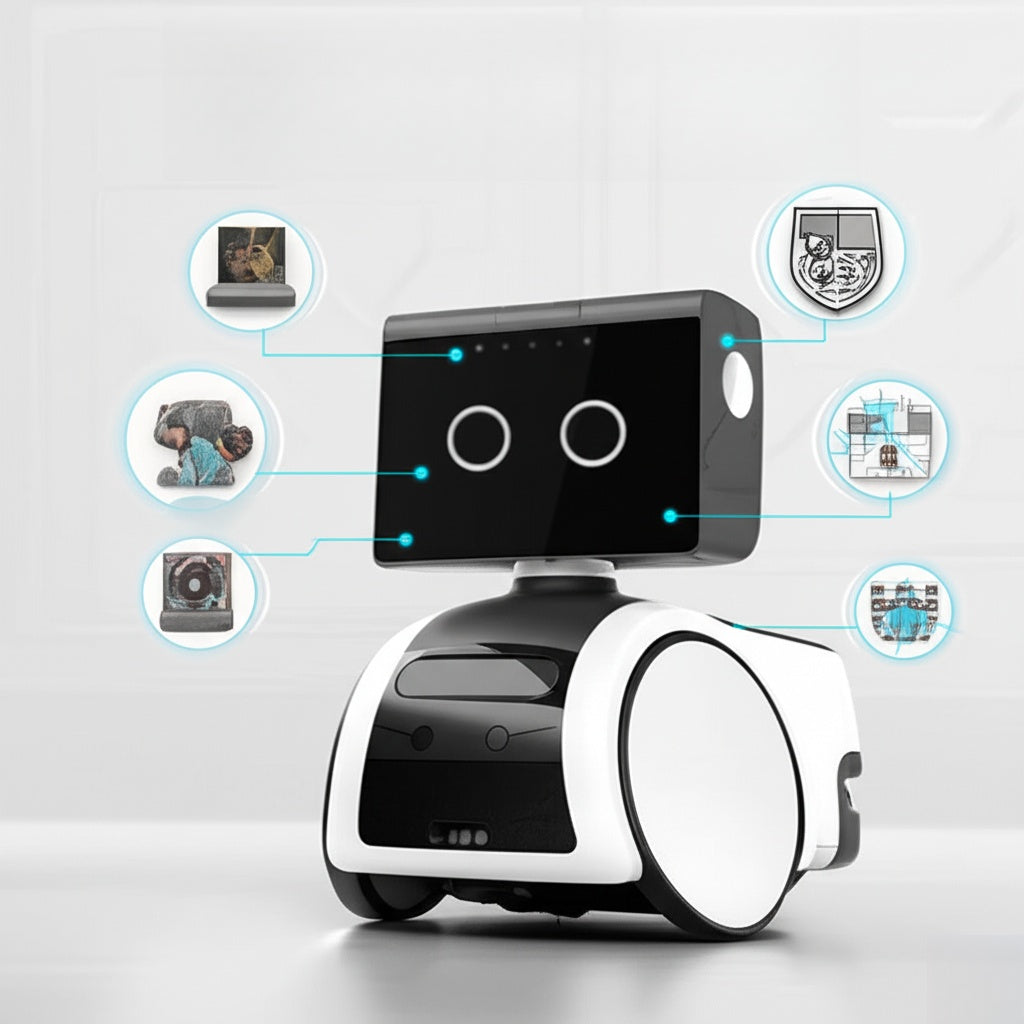Smart pet products have grown more and more smarter—from basic toys to AI pet companions that learn, adapt, and offer real emotional support.
This complete guide will help you explore this dynamic and expanding market. We’ll give a side-by-side look at top robot pets, checking key features, benefits, and drawbacks. Help you pick robotic pet wisely and find your perfect match.
Categorizing Today’s Robotic Pets
Let's break down robo-pets by their main job and vibe. Picking right one, it depends on both budget and what you want: a lifelike pal, therapeutic aid, fun learning toy, or tech platform for research.
High-End AI Companions: The "Future Pet"

These AI pets are technologically advanced, but also expensive. They learn and develop their distinct identities via everyday contact with their owners and surroundings.
-
Key Example: Sony Aibo (ERS-1000) – A premium, realistic robotic dog. Learns and adapts to environment and your family. Acts like a real dog using 22 actuators in the head, legs, and tail. Its OLED eyes blink and shift with mood. When the battery is low, Aibo can navigate itself back to its charging station.
-
Key Example: Lovot – This Japanese unique companion robot just only one purpose: to be loved. She has soft fur and touch sensors, you'll be feel warms up when hugged. Lovot can also learn and adapt to your home and family, recognise faces/voices, grow its own personality. It can also self-charge by finding its "Nest" charger when its battery is low.
Therapeutic & Realistic Companions: The "Fuss-Free Friend"

These robotic pets focus on emotional and sensory comfort. Often simpler and less mobile than high-end AI companions, they aim to soothe reliably. Perfect for seniors or people facing dementia, anxiety, or PTSD.
-
Key Example: Tombot Jennie – made by Jim Henson's team– A therapy robot-dog with realistic soft fur, movements. Built for deep emotional support and companionship. Barks, whines, snores, recorded from a real Lab. Eases loneliness and stress, zero real pet hassle.
-
Key Example: Ageless Innovation Joy for All Cats – Hugely popular, budget-friendly toy robot cat. A cuddly plush pal meant to comfort. Responds to touch and voice with lifelike meows and purrs. Its "Vibrapurr" tech mimics a real cat's gentle rumble. Simple design is the key feature, exactly why it’s a calm friend.
Interactive & Educational Bots: The "STEM Buddy"

These robotic pets blends fun and learning. They are made for kids, teens, and tech-loving families wanting to explore robotics, AI, and coding through interactive play. These robots are companions and powerful learning tools.
-
Key Example: Loona (V24) - Loona is a smart robot dog with lively expressions and movements. It recognitises faces and gestures using a high-end RGB camera and maps surroundings with a 3D-ToF camera. Loona excels with ChatGPT integration, enabling natural chats, storytelling, and drawing ideas from speech. It also uses Google Blockly, an app-based system, to teach children coding basics.
-
Key Example: Petoi Bittle - Bittle is a build-it-yourself, open-source robot dog for geeks, programmers, and STEM students. Users assemble it from a kit, which is central to its learning value. It's a highly agile, servo-driven bot programmable with Scratch-like blocks, C++, or Python. This product is an experimentation space for coding and robotics fans, it can be extended with optional cameras, sensors, or a robotic arm.
Bionic & Research-Grade Robots: The "Developer's Dream"

This final category stands apart. These don't fit the typical companion mold. They are advanced, bio-inspired quadruped robots built for research, industry, or serious hobbyists. Their design favors powerful movement and high-end sensors over emotional connection.
-
Key Example: Unitree Go2 Series—From China's Unitree Robotics, the Go2 is a highly advanced bionic robot dog. It moves with impressive agility, flipping, rolling, climbing obstacles, and recovering fast. Packing a 4D LiDAR L1 sensor, it offers professional-style 360° ultra-wide obstacle scanning.
-
Key Example: Xiaomi CyberDog— The CyberDog is a similar bionic quadruped robot with 11 advanced sensors. It's highly nimble, performing realistic dog-like movements. Its open-source setup invites developers and researchers to customize its functions. Importantly, it focuses on function, not emotional support.
This market approach reveals a core design principle. Products like the Joy for All Cats are designed simply and stationary because they're meant for therapeutic comfort. This simplicity isn't a limit; it's a choice making the product work better for its purpose. In contrast, the advanced movement and coding of a Petoi Bittle or Unitree Go2 serve a different need: to teach, challenge, and inspire. Understanding this design difference is key to choosing the right product.
A Detailed Comparison of Core Functions & Features
When choosing robotic pets, look past general descriptions and compare specific features. The table below gives a detailed side-by-side look at key models across different categories.
| Robotic Pet Model |
Type |
Price Range |
Realism Level |
Key Interactive Features |
AI Pet Capabilities |
Battery Life |
Primary Audience |
| Sony Aibo |
Robot Dog |
Very High (~$2,900) |
High (visual/behavioral) |
Voice commands, touch sensors, app control |
Learns & develops unique personality, face recognition, cloud-based memory |
~2 hours continuous |
Adults, tech/pet fans |
| Loona (V24) |
Robot Dog |
Mid-to-High (~$430-530) |
High (behavioral) |
Voice commands (ChatGPT), gesture/face recognition, games |
Conversational AI, maps rooms, receives regular updates |
~2-4 hours continuous |
Families, teens, STEM learners |
| Tombot Jennie |
Robot Dog |
High (~$450) |
Hyper-Realistic (tactile/sounds) |
Touch sensors, voice commands, app customization |
Limited emotional depth, but provides therapeutic responses |
All-day (unspecified) |
Seniors, individuals with anxiety/dementia |
| Joy for All Cats |
Toy Robot Cat |
Low (~$125) |
Moderate (plush fur) |
Voice/touch response, purring, heartbeat |
Simpler AI for calming effects; no learning |
~3 weeks (C batteries) |
Seniors, dementia patients, children with special needs |
| Petoi Bittle |
Robot Dog |
Mid-Range (~$230-280) |
Low (DIY/bionic) |
IR remote, app control, voice commands |
Open-source platform for programming and advanced projects |
~1 hour continuous |
Hobbyists, programmers, STEM educators |
| Unitree Go2 |
Robot Dog |
Very High (~$2,550) |
Low (bionic) |
Mobile/voice control, app control |
Advanced autonomous navigation, open-source ecosystem |
~2-4 hours continuous |
Robotic lovers, researchers, tech enthusiasts |
The True Cost of Companion Robots - A Pros and Cons Analysis
The decision to purchase a robotic pet is a balance of features, cost, and purpose. While the benefits are compelling, the drawbacks must also be carefully considered.
General Pros of Robotic Pets
-
Hassle-Free Companionship: Get pet companionship without real-animal chores. There are no vet costs, feeding schedules, walks, or grooming. Best for people who are busy, have restricted mobility, or live in a non-pet apartment.
-
Therapeutic Benefits: Research shows that robotic pets can aid with treatment. They ease anxiety, agitation, and loneliness—especially for seniors and dementia patients. One study even found lower painkillers and psych med use after robot sessions.
-
Allergy-Friendly: Love pets but hate allergies? Robotic pets fix that. Enjoy a pet-like buddy with zero sniffles or reactions.
-
Low Risk of Harm: Robotic pets won’t hurt vulnerable users. No harm from accidental rough play, stepping on them, or forgotten meals. Makes them safe pals in care homes where real pets stress staff.
General Cons of Robotic Pets
-
High Cost: Robotic pets range widely in price. Simple plush models start under $150, but top AI companions like Aibo cost nearly $3,000. This big spend scares off unsure buyers, especially those questioning long-term value.
-
Limited Battery Life: Most advanced robot dogs have short battery life, like Unitree Go2 and Loona run 2-4 hours. Petoi Bittle, maybe just one hour of play before recharging. This breaks up fun and forces new "care"—keeping it charged.
-
Data and Privacy Concerns: Cameras and mics in bots like Loona make families ask, "Who's watching?" Especially with kids around. Makers like KEYi Tech say they process data on-device, but third-party sharing? Buyers should dig deeper.
-
Ongoing Fees: Premium robots like Sony Aibo lock key features behind paywalls. Cloud learning needs a subscription. That extra yearly fee piles onto the real ownership cost.
Category-Specific Pros and Cons
The "hassle-free" claim is very attractive, but it's relative. Robotic pets ditch live pet chores yet bring new technological responsibilities.
Joy for All robot cat stays simple—just swap C batteries every few weeks. But a premium AI robot pet like Aibo, a mandatory subscription, needs Wi-Fi, craves a charging station. Similarly, a learning robot like Petoi Bittle demands assembly and faces finicky calibration—a whole new "tech pet care." The trade-off isn't pet versus no pet. It's biological chores versus tech chores. Truly hassle-free? Usually basic, stationary bots. Premium AI pets need a different owner investment.
Who Is a Robotic Pet For? Purchase Recommendations for Every User
The best robotic pet isn't the fanciest or priciest—it's the one that matches your needs and life. Pick based on who you are and what you need for a smart, satisfying choice.
For Seniors & Caregivers
For seniors or people with dementia, the goal is a calming friend that eases loneliness.
-
Recommendation: Ageless Innovation Joy for All Cats. Robotic pets are priced around $125, this robot cat is a budget-friendly option. Its lifelike fur, purring, and gentle movements give comfort. Simple interactions won't overwhelm dementia patients—proven effective.
-
Recommendation: Tombot Jennie. If you want premium therapy, Jennie offers ultra-realistic soft fur and moves (designed by Jim Henson's team). Built specifically to support anxiety, PTSD, or dementia, it's a top pick for this need.
For Families & Kids (Ages 6+)
Families and parents seeking a playful companion that also offers educational value will benefit most from robots that blend entertainment with learning.
-
Recommendation: Loona. As an interactive AI pet, Loona is a superb choice for a family companion. Its ability to engage in conversation via ChatGPT, play games like fetch, and offer coding lessons through Google Blockly makes it a versatile educational and entertainment tool. Loona's personality-driven interactions and ability to function as a home monitoring camera also make it a valuable smart pet product for the whole family.
-
Recommendation: Zoomer Playful Pup. The Zoomer Playful Pup is an excellent alternative for youngsters aged 5 and up who want a low-cost interactive robot dog. It recognizes voice commands, can learn over 25 tricks, and has LED eyes that convey emotions. Its simple, highly interactive nature makes it a perfect entry-level companion for kids.
For the Tech-Savvy & Hobbyists
This user group is not looking for a traditional companion but a platform for learning, experimentation, and serious robotics.
-
Recommendation: Petoi Bittle. With a robotic pet pricing of roughly $230, the Bittle is an affordable, open-source platform for hobbyists and STEM instructors. Users can assemble it themselves and program its movements using Scratch-like blocks, C++, or Python. This is a robot that grows with the user's skills, making it an excellent long-term investment for a learner.
-
Recommendation: Unitree Go2. For the most serious robotics enthusiasts, the Unitree Go2 is a bionic robot dog built for advanced applications. While its robotic pet price of over $2,500 places it firmly outside the consumer pet category, its advanced locomotion and open-source ecosystem make it a dream machine for developers and researchers seeking a high-performance bionic robot. This distinction between a consumer AI pet and a developer's bionic robot is critical for avoiding a costly purchase that doesn't align with the user's purpose.
For the Budget-Conscious Buyer
For those with a tighter budget, there are still excellent options that provide genuine value and interactivity.
-
Recommendation: Ageless Innovation Joy for All Cats. This model, with its therapeutic benefits and low robotic pet price, is an ideal choice for anyone seeking simple, comforting companionship.()
-
Recommendation: Moji Interactive Labradoodle. For a mid-range interactive robot dog, the Moji Interactive Labradoodle offers voice commands and petting sensors, providing a rich interactive experience without the premium price tag of an Aibo or a Go2.
FAQs
Are Robotic Dogs Just Toys?
No, it has grown way past simple toys. Many toy robot cats and robot dogs entertain, but today's market offers serious devices too. Therapy robotic pets are medically proven helpers in healthcare, easing anxiety for dementia patients. Educational robots Petoi Bittle and Loona teach real STEM, AI, and coding. Then there are bionic bots—like Unitree Go2—built for research or factories, not friendship. So while some stay simple, they're way beyond playthings.
What Are the Real Benefits of Robotic Pets?
The advantages of robotic pets are numerous—often research-supported. They can help treat: decreasing anxiety, improving spirits, and battling loneliness, especially among the elderly.
They give companionship and daily spark without feeding, walks, or vet bills—perfect for limited mobility or allergies. For families, they're fun buddies teaching kids caring, social smarts, and coding basics.
How Much Does a Robotic Pet Cost?
Robotic pet prices vary widely based on the category and degree of technology. Simple therapy robots like Joy for All Cats are budget-friendly picks at $125-$150. Mid-range learning robots like Loona cost $400-$600. Top AI companions like Sony Aibo, start at around $2,900 starter price. Watch for hidden fees—some premium models need subscriptions to unlock everything.
What About Robot Pet Scams?
Spotting scams is key in this market—especially fake robot puppies. These traps flood YouTube and Facebook, often targeting non-tech-savvy individuals. Scammers use AI videos showing impossible tricks that no real bot can do. Red flags for unrealistic prices, junky ads with irrelevant music, and no real return address or phone number. Many fake listings even steal photos of real dogs to push cheap plush toys. These scams demonstrate that many buyers lack critical expertise. True expertise here means knowing both what to buy and how to evaluate technology claims. Avoid scams: only buy from official trusted sellers and ignore "too good" prices.
Conclusion: Your Next Steps to Smart Pet Ownership
The world of robotic pets buzzes with options for everyone. The perfect match isn't a one-size-fits-all thing—it's a thoughtful pick matching what you need. Comfort for elderly loved ones? Fun learning for kids? This guide showed the market's split by design goals. So the fanciest bot might not be your best fit.
Truly winning smart pet products? Those fitting smoothly into daily life and nailing a real need. Companion warmth? Family fun? Hands-on learning? Know the bot's true job. The future of friendship is here—but is it worth it? Measured by how closely these tech wonders match our hearts and needs.











